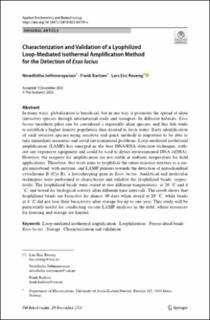Characterization and Validation of a Lyophilized Loop-Mediated Isothermal Amplification Method for the Detection of Esox lucius
Peer reviewed, Journal article
Published version
Permanent lenke
https://hdl.handle.net/11250/3127046Utgivelsesdato
2023Metadata
Vis full innførselSamlinger
- Institutt for mikrosystemer [546]
- Publikasjoner fra CRIStin [3623]
Originalversjon
Jothinarayanan, N., Karlsen, F., & Roseng, L. E. (2023). Characterization and Validation of a Lyophilized Loop-Mediated Isothermal Amplification Method for the Detection of Esox lucius. Applied Biochemistry and Biotechnology. https://doi.org/10.1007/s12010-023-04799-xSammendrag
In many ways, globalization is beneficial, but in one way, it promotes the spread of alien (invasive) species through international trade and transport. In different habitats, Esox lucius (northern pike) can be considered a regionally alien species, and this fish tends to establish a higher density population than desired in fresh water. Early identification of such invasive species using sensitive and quick methods is important to be able to take immediate measures and avoid environmental problems. Loop-mediated isothermal amplification (LAMP) has emerged as the best DNA/RNA detection technique, without any expensive equipment and could be used to detect environmental DNA (eDNA). However, the reagents for amplification are not stable at ambient temperature for field applications. Therefore, this work aims to lyophilize the entire reaction mixture as a single microbead, with enzyme, and LAMP primers towards the detection of mitochondrial cytochrome B (Cyt B), a housekeeping gene in Esox lucius. Analytical and molecular techniques were performed to characterize and validate the lyophilized beads, respectively. The lyophilized beads were stored at two different temperatures, at 20 °C and 4 °C, and tested for biological activity after different time intervals. The result shows that lyophilized beads are bioactive for almost 30 days when stored at 20 °C, while beads at 4 °C did not lose their bioactivity after storage for up to one year. This study will be particularly useful for conducting on-site LAMP analyses in the field, where resources for freezing and storage are limited.

